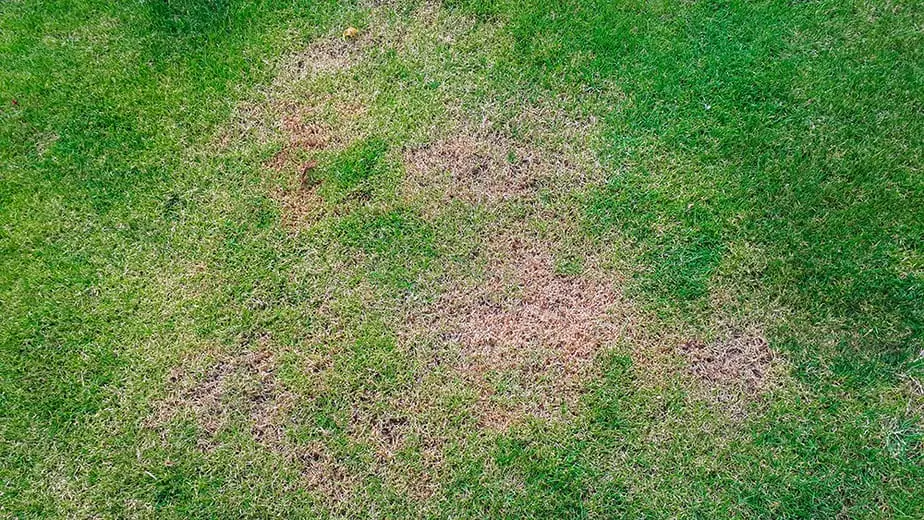Explore how to repair your Bermuda lawn or Zosyia lawn, and also assess the winter damage before spring!
Winter can be tough on Bermuda and Zoysia lawns in Atlanta, GA, leaving behind unsightly brown patches and damaged grass. But don’t worry. You can fix this winter lawn damage and restore your lawn’s lush green look in the early spring. We’ll go over the steps you need to take to repair your Bermuda or Zoysia lawn after winter damage in the Atlanta area. Let’s discuss the signs of a damaged Bermuda or Zoysia lawn you should look for before we go through the repair process.
Damaged Lawn Signs You Should Check
Signs Of Damaged Bermuda Lawn
Bermuda grass is a warm-season grass that winter weather conditions can damage. Here are some signs that your Bermuda lawn may have been damaged by winter:
- Brown or yellow patches: One of the most noticeable signs of winter damage in Bermuda grass is the appearance of brown or yellow patches in the lawn. Cold temperatures, frost, or snow cover can cause this.
- Thinning: Another sign of winter damage is thinning of the grass. This can happen when cold temperatures weaken the grass, and it is more susceptible to disease and pests.
- Slow growth: Bermuda grass that has been damaged by winter may have slow growth in the spring. Therefore, if you are experiencing a slow growth of Bermuda grass after winters are over, it’s time to understand!
- Dead grass: In severe cases, winter damage can cause the grass to die. This can be seen as large areas of dead grass or grass that do not come back in the spring.
- Weeds: A damaged Bermuda lawn can also be more susceptible to weed growth. Weeds can thrive in areas where winter damage has weakened grass.
If you notice any of these signs in your Bermuda lawn after winter, it’s important to take action to repair your Bermuda lawn.
Signs Of Damaged Zoysia Lawn
Zoysia grass is another warm-season grass that winter weather conditions can damage. Here are some signs that your Zoysia lawn may have been damaged by winter:
- Brown or yellow patches: One of the most common signs of winter damage in Zoysia grass is the appearance of brown or yellow patches in the lawn. A few factors contributing to brown or yellow patches include cold temperatures, snow cover, and frost.
- Delayed green-up: Zoysia grass that has been damaged by winter may have a delayed green-up in the spring. This is because the grass is using its energy to recover from the winter damage.
- Thinning: Winter damage can cause the Zoysia grass to thin out in some areas, making it more susceptible to weeds and pests.
- Slow growth: A damaged Zoysia lawn may also exhibit slow growth in the spring. This is because the grass is using its energy to recover from the winter damage.
- Dead grass: In severe cases, winter damage can cause the grass to die. This can be seen as large areas of dead grass or grass that do not come back in the spring.
If you notice any of these signs in your Zoysia lawn after winter, it’s important to take steps to help your lawn recover. Proper fertilization, watering, and aeration can all help to promote healthy growth and repair the damage caused by winter weather.
Steps To Repair Your Bermuda Lawn Or Zoysia Lawn
Assess the Damage Before You Repair Your Bermuda Lawn
The first step before your repair your Bermuda or Zoysia lawn is to assess the extent of the damage. Walk around your lawn and look for areas of brown, dead grass. Some damage is normal, but it’s time to take action if you see large patches of dead grass. Here are the areas you need to focus on when assessing damage:
Look for discoloration: Walk around your lawn and look for areas of discoloration. Damaged Bermuda grass by winter stress will often have brown or yellow patches.
Check the soil: Check the soil around the damaged areas to see if it’s too compacted or too dry. Soil compaction can prevent water from reaching the roots of the grass, while dry soil can lead to dehydration and stress.
Inspect the grass blades: Inspect the grass blades for any signs of damage or disease, such as brown tips or spots, mold, or fungus.
Test the grass’s resilience: Try pulling on the grass blades in the damaged area to see if they are firmly rooted. If the grass comes up easily, it may be a sign of shallow roots, which can indicate winter damage.
Consider the weather: Think back to the weather patterns during the winter months. Cold temperatures or heavy snowfall increase the likeliness of damaged Bermuda grass.
Contact a professional: If you’re unsure about the extent of the damage or how to repair it, consider contacting a lawn care professional who can help you assess the situation and provide recommendations for treatment.
Remove Dead Grass
Once you’ve identified the dead grass, it’s time to remove it. You can use a rake or a lawn dethatcher to remove the dead grass and any accumulated debris over the winter. Removing dead grass will allow the healthy grass underneath to receive sunlight and air, which will help it to grow.
Aerate the Soil To Repair Your Bermuda Lawn
After removing the dead grass, it’s time to aerate the soil. Aerating involves creating small holes in the soil to allow air, water, and nutrients to penetrate deeply into the roots of your grass. This will help your grass grow more vigorously and improve your lawn’s overall health.
As a lawn owner, you can adopt different aeration techniques, but liquid lawn aeration is considered one of the most effective ways to penetrate nutrients into the soil. In liquid aeration, the product is mixed with water and sprayed on the lawn with a garden pump sprayer. You can also use a hose-end attachment for spray.
You can rent an aerator or hire a professional to regenerate your lawn through liquid lawn aeration. It’s best to aerate your lawn in the early spring, just as your grass is beginning to grow again.
Reseed or Resod
You can reseed those areas with a Zoysia or Bermuda grass seed if you have bare spots. You may need to resod the affected areas if the damage is severe.
Reseeding or resodding refers to the process of replacing grass on a lawn or other landscaped area with new seeds or sod. Reseeding typically involves planting grass seed directly into the existing soil, while resodding involves removing the existing grass and soil and replacing it with pre-grown turfgrass.
You can use both methods to improve the health and appearance of a lawn. It also allows you to address issues such as bare or patchy areas and create a more uniform and lush landscape. Reseeding and resodding can be done at different times of the year depending on the climate and the specific type of grass being used.
Add Fertilizer
After aerating your lawn, it’s time to add fertilizer. Fertilizer will give your grass the nutrients it needs to grow strong and healthy. Using a slow-release fertilizer is best as it will provide a steady supply of nutrients over time.
It’s important to choose a fertilizer that is specifically formulated for Bermuda or Zoysia grass. These grasses have different nutrient requirements than other types of grass, so using the wrong fertilizer can actually do more harm than good.
Water Your Lawn
Once you’ve added fertilizer, it’s time to water your lawn. Watering your lawn will help the fertilizer penetrate deeply into the soil and help your grass grow. It’s best to water your lawn deeply and infrequently rather than watering it lightly and frequently.
Watering your lawn early in the morning is important. Why? Before the sun gets high and too hot, the water will have enough time to soak deeply into the soil.
Mow Your Lawn
Finally, it’s time to mow your lawn. Mowing your lawn will help to promote healthy growth and will also help to prevent weeds from taking over. It’s best to wait until your grass is at least 2 inches tall before mowing it.
Setting your mower blade to the appropriate height is important when mowing your lawn. For Bermuda grass, the blade should be set to a height of 1/2 to 1 inch, while for Zoysia grass, the blade should be set to 1 to 2 inches.
Conclusion
Winter damage can be frustrating for homeowners who take pride in their lawns. But with the right approach, you can repair your Bermuda or Zoysia lawn and restore it to its former lush green glory.
The key is to assess the damage, remove dead grass, aerate the soil, add fertilizer, water your lawn, and mow it appropriately. With these steps, your lawn will be healthy and beautiful again, and you can enjoy your outdoor space all spring and summer.
If you need professional help, you can always contact Guaranteed Green serving in Atlanta and surrounding neighboring cities. You can call our lawn care experts in several areas. It includes Sandy Plains, Winston, Hiram, Austell, Brookhaven, Dunwoody, and other metro areas. We will make sure to curate a personalized lawn care program for your lawn that solves all the problems from weed control to fertilization.



